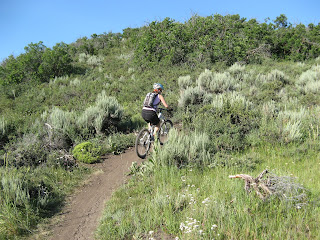The two cows were just out of frame
We started off along the Summer Road, above Albion Base, then took a short connector trail across a meadow to the main trail up Albion Basin/Sunnyside. The wildflowers are in full riot, maybe even a little past prime, and those Sunnyside meadows were stunning, with horsemint, paintbrush, lupine, sunflowers and at least two other flower varieties we haven't been able to identify. We were able to identify the three moose browsing the shrubs on the edge of the meadow. Our summer wildlife tally has mainly been on the small side, Sunday's coyotes notwithstanding, so adding not one, not two, but three moose so early in the hike was a bonus.
First sighting of elephant's head in the Sugarbowl
Continuing up the ski area, we passed Alf's and walked under the Cecret lift to the base of Supreme, where we got on the trail to Cecret Lake. What's fun about hiking ski areas in the summer is how different they look from when they're covered in snow - it became a game to figure out what lines we take in the winter, not to mention how much steeper everything looks in the summer. The trail to Cecret Lake was starting to get busy - although the shuttle from Albion Base was already running, so we figured most people hadn't hiked all the way up from the bottom as we had. We paused at the lake - swarming with small bugs, so there must have just been a hatch of some kind - then continued up a narrow trail to Cecret Saddle.
"Photos taken here"
From there, we got on the dirt access road, pausing several times for flower photographs, which brought us out to the EBT, right at the Alta/Snowbird gate. A large group of hikers was up there, refueling before heading up to Baldy; we went the other way, aiming for Sugarloaf. There was some construction going on up there - new snowmaking pipes and repairs - and we spoke briefly with one of the guys, who offered to take our picture ("Everybody say, 'Snowbird sucks!'") and who also gets credit for the title of this post.
Cecret Lake from Sugarloaf summit
It had been a while since we climbed to the top of Sugarloaf which is quite steep, with loose, rocky sections of trail. We gained a lot of elevation really quickly, however, as the summit is at 11,050 feet, and the trail was easy to follow. Despite the hordes swarming Albion Basin and Cecret Lake below, we had that mountaintop all to ourselves.
Marmot surveying his domain
The descent was quick (that Alta worker: "You guys got all the way to the top and back already? Whoo!"), despite the loose footing. Because making a loop is always better, we decided to go around the EBT and down through Collins; we've hiked up through Collins several times but we couldn't remember if we'd ever gone down. Before we made it very far around the EBT, however, we had to pause for a marmot portrait. There were two other of the chubby little guys but they declined to pose. We also had to pause at the top of Collins lift because there were two more moose down in a little pond above Keyhole. The bull was much older than the one we had seen on Sunnyside, evident because of the size of his antlers. Both he and the cow were just munching away, perfectly content in their high alpine haven.
Best lunch spot ever, if you're a moose
Going down through Collins via the access road was also quick - certainly quicker than going up, which is a grind and quite steep in spots - although we kept stopping to point out our ski routes and to marvel at just how damn steep the Main Chute looks without any snow in it. The wildflowers were not quite as spectacular as they were on the backside, until we got low down near Corkscrew/the bottom of High Rustler and then they were glorious again.
Wildflowers! Alta!
When we bottomed out at Collins/Wildcat base, we walked along the rope tow back towards where we had parked in the upper lot at Albion Base. Note: the rope tow is really no more fun in the summer than it is in the winter. We climbed back up to the parking lot, directed some folks to the trailhead for Cecret Lake, and then happily took our boots off while enjoying a late morning beer. For a hastily thrown-together hike, it turned out really well, due to the fact that there are an embarrassment of trails in the greater Salt Lake area. Plus, any day when your moose sighting outnumber your marmot sightings is a winner!
Hike stats: 7.82 miles; 3 hours 5 minutes hiking, plus 58 minutes of taking photos, eating, gawking at the scenery; average speed of 2.5 m.p.h.; 2,300 feet of elevation
























































